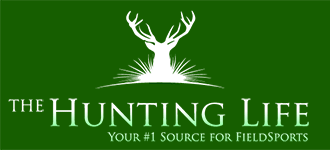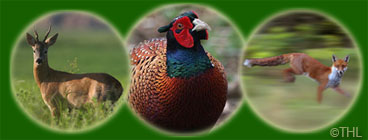A Yanks First Year Working Terriers
I never knew a time when we didn’t have a dog in the house. My parents had dogs before they had me and I cut my teeth on biscuits stolen from the dog. But I never had a terrier. Terriers to me were fuzzy, yappy, carpet-piddlin’ little ankle-biters that no real man would be seen with, until… A non-descript black and tan terrier mix adopted me while in the field in the early 80s. Over the next thirteen years he taught me to love terriers and that I’d always want one around.
He’d been free roaming before I got him and never did learn a reliable recall off lead so didn’t spend much time hunting, but his biggest problem was he was black. Couldn’t see him outside at night, and decided to correct that problem when the time came. Had a choice in white terriers – Westies or JRTs. Of course, I wasn’t going to be seen walking a Westie, so the choice was a JRT. We found one at our local shelter, a chubby, prick-eared little fella. We thought he was just overweight and that diet and exercise would correct it, but it turned out he had Cushing’s. We lost him too soon, but while researching the disease and terriers I stumbled upon the JRTCA and information about hunting with terriers. My life was gonna change!
Shortly after we lost our previous JRT, a local farmer, friend of a friend, had a male pup available from a recent litter - just what we wanted. Went to look at him at five weeks old, not so much interested in the hunting aspect yet just wanted another JRT. He was what we wanted, but his one littermate - a little female – came running up wigglin’ and waggin’ and my wife fell in love with her. We ended up committing to ‘em both. As they grew, the male got decidedly bigger while the female remained small. Trying to learn more about JRTs, I found more and more information about hunting with them. Poke, the male, was going to be too big to hunt around here, but Dot, the female, was gonna be the right size. I found a book, American Working Terriers, written by Patrick Burns, and made a few friends who offered some helpful advice. We worked on basic obedience training the first year we had the pups, and when they turned 14 months old in the fall of ’06, we began my first year of working terriers.
The first year actually began some months before our first trip out. I should mention, at the time I knew no one locally who hunted with terriers. The closest people I could find were some three to six hours drive away, farther than I cared to travel. If I was gonna do this, it looked like it was gonna be done from books, articles and long-distance advice. Armed with the information from Patrick’s book, advice from several people met on terrier-related message boards, and a few good hunting-related links, I set about putting together a hunting kit. First stop was a locator collar.
The old standby Deben MkI was coming to the end of its run, the MkII was a flop, and the MkIII was getting less than stellar reviews for terrier work. The Deben LRT was just coming on the market as was the Bellman & Flint, but neither was currently being sold in the U.S. After researching both the LRT and B&F, I decided on the LRT primarily based on the size. Several people mentioned that Ken Bushell had imported some of the first LRTs into North America, and it turned out he still had a box and two collars left. Not for long. Sent him a money order and waited for the postman to arrive. In the meantime, I started collecting the tools to dig to the dog.
What an experience. Lists of what you need are readily available. They’re numerous, and while each one contains certain basic items, each one reflects the personal preferences of the individual making the list as well as the requirements for the local area hunted. But I didn’t know that, all I knew was the dog was gonna go underground and it was my job to get to her. Soon the local hardware stores knew me pretty well as I amassed everything I might possibly need. It turned out to be a mistake, but more on that later.
Every equipment list stressed the need for a quality shovel, not the $9.99 ones from the local building supply. Ames’ D-handle Pony round point with a forged blade got high marks, so I set off to our local have-it-all hardware store, one of those places where if they don’t have it they can order it and if they can’t order it you probably don’t need it anyway. Hopes were high, but quickly dashed when they didn’t have one in stock. They could order it though. And they did. And then I waited. And waited. And waited some more. After six weeks, I finally decided to pay the shipping and order one from AM Leonard. It arrived a week later. Of course, two weeks after that the one from the local hardware store arrived too. Oh well, always best to have a back up available.
Most lists suggested a light digging bar. Patrick said a six-footer made from ¾” hex stock was just the ticket and hex stock was available at every welding shop. Maybe welding shops in Virginia, but not welding shops in Myerstown! Talked to a neighbor who works for the gas company. Figured if anyone knew where to find tools to make holes in the ground, he would. “No problem,” he says. “We use something like that to punch test holes. I’ll bring you one of our scraps.” And he did. Instead of ¾” hex though, it was 1” round and weighed a ton. But it was lighter than any other digging bar I’d ever used, and I didn’t know any better. Shovel and bar, what next?
Found a trapper’s trowel at the local Gander Mountain, pruners and folding trimming saw at the local hardware, lineman’s pliers, bolt cutters, one-handed pick/mattock from Home Depot. Scraper cut down from an old hoe in the shed. Found a folding GI shovel in my camping gear. Put together a snare pole when the hog catcher from Tractor Supply seemed too heavy. Gotta save weight somewhere! Then I ordered a pack, a GI surplus large Alice pack with frame, which I was familiar with and seemed designed to carry the load I was acquiring. Added a first aid kit. Added two, a big one that rides in the truck and a little one in the pack. Nets, tie-out, leads, water bottles for me and the dog. Gloves, flashlight, knife from gear already owned. Finally, added some heavy digging tools from the shed – pick/mattock, heavy bar, post hole diggers, extra shovel. When I shouldered the pack, I knew I was ready for anything. If I could only carry it there. But we were finally ready for our first day in the field. At least physically, anyway. And some tools seemed more useful in the store than when they were in the pack.

Got the first chance to take Dot into the field November 2, 2006. Frankly, I was concerned. Never actually did this before; never had Dot off lead outside a fence. Not a clue about whether she would know what to do, and fearful that she would and I wouldn’t. It turned out to be little more than a walk in the fields with the dog, but I discovered that Dot wouldn’t run off never to be seen again if she were off lead, and she wasn’t shy about sticking her head in holes or even entering to check ‘em out. We got out again several times over the winter, never finding quarry, but each time my confidence and comfort level rose a bit both in myself and Dot. Looked like we were at least going to enjoy spending time together wandering the fields if nothing else. Learned that I could trust her to behave and she could trust me not to spoil her fun too much. We were becoming a team.
In late March, we finally got to see just how good a team we were. Been seeing groundhogs for several weeks drivin’ back and forth from work, and had a few places I knew we’d be able to spot ‘em across the fields. Went to one of ‘em, and there was a ‘hog feeding 200 yards out. It ducked inside as we approached, but I knew where it was. Now… Could Dot find it?
When we got near the hole, Dot lit up. She entered and was working in short order. Our first quarry! Found I could work the LRT just as described - a load off my mind – and located her two and a half feet down. Gave her time to settle, thumped the ground with the shovel to make sure, and started my first dig. Amazing. Dot was there when I got down to her, and the groundhog was there too. Less than a forearm’s length in front of her and digging away. Never been that close to a live groundhog in my life. (I usually shoot ‘em at 200+ yards.)
All sorts of things I could and should have done at this point, but none of them came to mind. Ultimately, the ‘hog dug away and we lost it when it bolted, but we were on our way. This was gonna be fun!
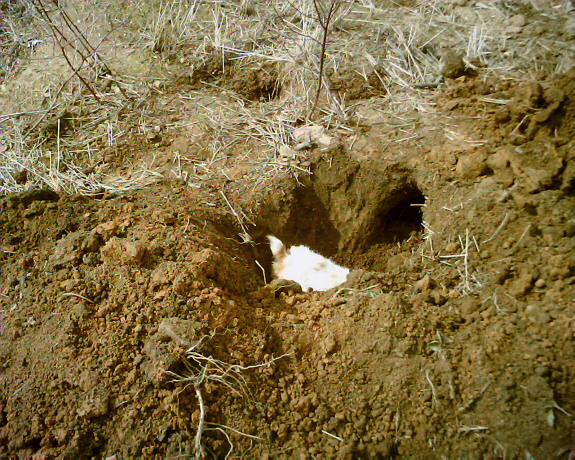
Mid-April was our next chance to have some fun, and what fun this time turned out to be. Just as before, I spotted a feeding ‘hog in a field and took a roundabout path to it so Dot would have a chance to find it. This was a two-eyed den in the middle of a field. Dot picked the hole she liked and was in and working in seconds. Then back out, in the other hole and working again. She repeated this for about fifteen minutes, always returning to the same spot. Finally, I located her at four feet deep and started to dig. When I broke through to the tube, there was Dot but no sign of a groundhog. Dot was insistent on digging at the side of the hole, but it seemed there was nuthin’ there but more dirt. But one piece of advice I did remember this time was, “Always trust your dog.” Shaving the side and probing where Dot was digging ultimately opened to a stop end the ‘hog had blocked. I couldn’t see it, but Dot knew it was there and wanted me to find it. This time I was a little more prepared for the finish, and a blow with the bar administered a quick coup-de-grace. Our first quarry dispatched. What a thrill, and what a feeling of elation. We’d worked it right and we’d worked it together.
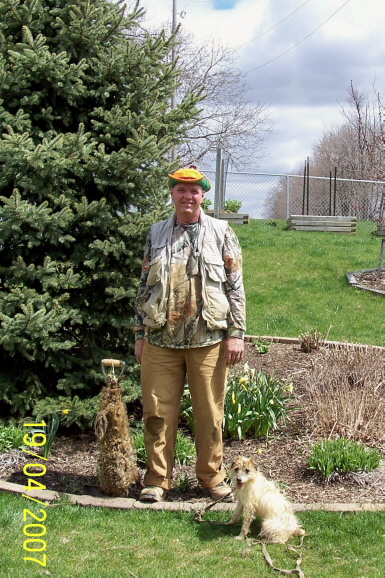
While it was certainly a thrill taking our first quarry, mid-May started some even more satisfying adventures. Jo had invited me to hunt with him and Greg, and our mutual schedules and the weather finally came together to let it happen. A three-hour drive took us to southern New Jersey and I finally got to meet two guys I knew only from our correspondence and a few phone calls.
The first thing they told me was my kit was way too heavy for digging in their area, and probably for my area as well. I ended up leaving my kit in the truck, slung a shovel over my shoulder and a couple bottles of water in my pockets as we set out. Jo had his terrier Otter and his lurcher Rippa. I had Dot. We checked a bunch of settes, dug four or so, and got two groundhogs. The NJ sand was a whole new experience for me, a real different game than the clay, loam and shale around here. Groundhogs might dig through my soil but they swim through that sand. Rippa on top made quick work on bolts, far easier than netting and blocking boltholes. This was not only the first time that I was out with other hunters, but the first time Dot was exposed to other dogs hunting as well. I was pleased that she didn’t fight with either the terriers or lurcher, and was well behaved when another dog was working a hole. Guess the effort to socialize her to other dogs from early on was paying off. It was a good day with new friends, and an experience we’re looking to repeat. Hunting alone is fun; hunting with friends is even more fun.

We drove home, got cleaned up and put the gear away. The telephone rang; it was Roger. He wanted to know if I was up for a Sunday at his place. Hey… two hunts in five days? Why not? Roger took two terriers, Gyp and Neb, and I took Dot. Again, Dot got along fine with the other terriers. We got to the corner of a field, Gyp started working in one direction and Dot in another. Roger and I split up to follow our dogs and could hear each other working but not see each other through the undergrowth. Dot was working a two-eyed sette at the base of a large tree. When she settled, I marked her at four feet and blocked the second hole with a large rock. Was just getting ready to dig when Roger returned. Dot was still pushing the ‘hog, and it managed to push the rock out of the way and bolt. We checked a lot more holes, and Dot and Neb teamed up on a huge multi-eyed sette, but in spite of some occasional baying underground, we came up empty on that one. Baby ‘hogs maybe? Called it quits and finished the day on Roger’s deck with cool drinks and good conversation.
Got out a few more times in late May, early June with mixed success. Then, had an interesting and embarrassing day. Hotter’n a three-dollar watch, baked shale in a mowed hayfield. Three-eyed sette, Dot working well. Got a mark at three feet and started to dig. The shovel was nearly bouncing off the surface. Only got about eight inches deep before the ‘hog bolted. Temp was already in the mid-90s by then, so we decided to move to easier digging. On the way, I dropped the front of the truck into the drainage ditch lining the farmer’s lane. He yanked me out with his tractor. Tough dig, no ‘hog and a stuck truck. Not one of our best.
But a week later we made up for it. Beth drove down from NY and brought four dogs. I took Dot. We dug the first hog at two and a half feet from the first sette we checked, Toby and Dot working together. Then another fifty yards away, we dug the second ‘hog at three feet. Milk pulled this one for two ‘hogs in two hours. Fifty yards farther, we were on the third dig, a tough four-eyed sette wrapped around an old stump and roots. Beth brought out Terra for this one, and two four-foot digs on opposite sides of the stump gave us two ‘hogs. Had to work with saws and post hole diggers, but we got ‘em both after about two and a half hours of digging. We finished the day with Italian take-out and conversation on my deck.

Another week later brought another visitor – Ken was passing through and stopped for some digging. He brought one of his Borders, two experienced and one young Jack. We dug a three footer to dispatch on a young’un and bolted momma from the same den. Followed her to the next sette and dug her at five feet to another dispatch. Worked another sette in a new-mown hayfield but lost it when the tube ran under a massive limestone slab. Ken’s dogs did most of the work on these, but when we moved to another field Dot worked a bolt single-handed, pushing through the tube end-to-end. I missed the snare, but Dot done her part.

The end of June brought another of those memorable moments that are better looking back on than actually experiencing. Working a hedgerow along a bean field, Dot entered a hole in a pile of rocks. Decided to block a bolthole with some of the rock. Started pulling rocks, and one of them was covering a large ant colony. The ants liked being dug out of their home even less than the groundhogs, and decided to show their displeasure by swarming up my arms. Started practicing my Anglo-Saxon expletive while brushing ‘em off. Dot, hearing something other than my, “Good girl. Get the groundhog,” decided to see what I was up to and backed out through the swarm. Now we were both covered with ants. Picked her up, backed out of the hedge into the beans and did an animated dance scraping ‘em off the two of us. Glad it was well away from the road and witnesses. Figured it was a good time to call it a day.
Got out another time or two, and then mid-July gave one of our most memorable days. Just got a new permission at a nearby orchard. The owner said it was loaded with groundhogs, and he wasn’t kidding. Dot worked the first groundhog to a bolt not thirty feet from the truck. She bolted two more from neighboring dens with no digging and two that bolted while we were digging to them. The day was warming up and we moved over a few rows to get into the shade. Came onto a multi-eyed sette surrounding the base of a cherry tree. Dot lit up. In and baying, then out and in another hole with more baying. A ‘hog bolted from one hole to another with Dot in pursuit. Then it happened again. We’d discovered Groundhog Grand Central Station. I started blocking holes with my pack, bar, yoho and dirt then kneeled in front of one. When Dot finally settled I marked her at two feet and started digging. Opened to a four-way split in the tube. Dot’s working and I hear teeth clicking. She pushes the hog to the hole; I thump it with the bar and pull it out. She’s still working. Dug a second hole, tailed out number two. Number three sticks its head out far enough to dispatch with the bar, and she’s still working. Sink a third hole and tail out number four. Dot’s still working, and as I dispatch the fourth one, a fifth bolts with Dot in pursuit. She grabs it by the butt, but it’s big enough to drag her toward a hole that had been blocked until I need the bar that was blocking it. I get there to tail it just as it breaks free from Dot’s grasp and it gets away. I’m tired now. We’ve been at it for six hours, three on this last sette. I pick up Dot, wash her eyes, give her a drink and backfill the holes. Keep her on lead for the walk back to the truck ‘cause I don’t want her finding another one. Putting the gear in the truck, another ‘hog dives in a hole not thirty feet away. That one’s gonna have to wait ‘til the next time. One man, one dog. Three bolted without digging, three dug to bolts and four dug to dispatch. We’ll remember this day for some time.

Another few trips out with mixed success, and then Beth came back the end of July with some of her dogs. Hot and humid, but no rain in several weeks. Everything bone dry. We went back to the orchard and dug one from the hedgerow east of the orchard. Getting uncomfortably hot for both people and dogs, we headed back to the truck. Dogs decided to investigate a five-eyed sette, and three different dogs liked a spot five feet in and two and a half feet down. This dig was terrible – sun-baked shale and temp above 90. Had to get the heavy bar from the truck to chip through the concrete-like dirt. Opened to a tight, twisted tube where the dogs were having problems making the turn. Cleared a little, re-entered the dogs, another five feet in and two and a half feet down. Chipped away again. Couple hundred reps of twenty-five pound curls with the bar and we opened to another tight twisted tube where the dogs were stuck again. Screw it. Hot, sweaty, dogs panting. Drank a gallon of water by now and still whizzin’ orange. Pulled the dogs and called it a day.

Got out during August and early September, again sometimes with success and sometimes just enjoying time in the field. End of September gave us a near textbook experience. Nice cool morning and we returned to the orchard. Dot entered a sette that had stymied us the week before and was working within seconds. Settled twelve feet in and two feet down. Opened to Dot’s back, and clicking teeth with a ‘hog’s head poking from a stop end, Dot wisely just out of range of the darting snaps. Decided to go for a snare rather than dispatching with the bar, drove the bar into the tube behind the ‘hog and rattled it to convince him forward was better than backward. Short struggle and quick dispatch from a whack with the yoho ended it. Backfilled and took a ten minute drive home. Passed the owners on the drive and showed ‘em our latest work. Two happy farmers.
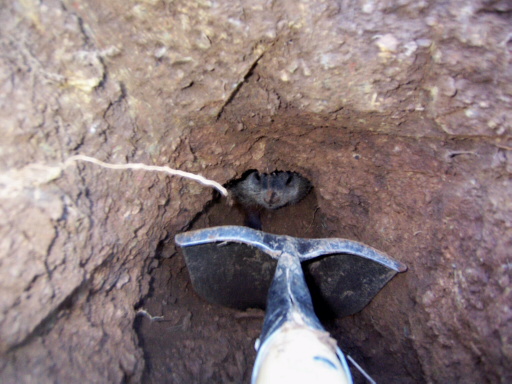
A busy schedule at work and home plus muzzle loading deer season kept us out of the field during October and our next opportunity came on November 2, the anniversary of our first trip a both long and short year previous. Got a late start and checked several areas coming up empty before arriving at, ironically, the same den where we’d work that first groundhog that dug away back in March. We’d taken three ‘hogs from this den over the summer plus the one that got away. Today Dot said there was yet another one at home. This time it was six foot in and four foot down. Dug through heavy damp clay and opened to Dot’s back end as she dug through heavy kickback. Opened the hole a bit and she was pulling bedding. Clearing behind her and shaving the hole, I could hear the ‘hog digging away in front of her. Every time I’d just about decided that I needed to sink a hole in front of the ‘hog to cut off its escape, Dot would get close and really light up. I glanced over my shoulder, and noticed I now had a six-foot long four-foot deep trench cut. The sun was dropping lower on the horizon, and it was now 5:00 o’clock in the afternoon. We’d been working this one for almost four hours. With less than an hour of daylight left, I didn’t think we were gonna get this one in the time we had left, so pulled Dot, backfilled a really big hole and headed home. Our first year ended in the same den we’d dug on our first dig, and with the same results – the ‘hog digging away and escaping. But unlike the first time, this time we knew what was happening and what we were doing. The first one got away from ignorance, this one got away from a conscious decision. A big difference.
So our rookie year ended with twenty-two trips to the field, seventeen times alone and five times with friends. We dispatched fifteen groundhogs, bolted another fourteen, and lost at least eleven more that Dot said were there but I couldn’t get to. A good year? I don’t know. But an interesting, enjoyable one that taught us a lot of lessons.
So what did I learn in this rookie year? Probably a lot that’s obvious to anyone who’s been doing it a while, but is new to me. It’s often said it’s not rocket science. It’s possible to learn it on your own with a few references and a lot of advice. There’s an old adage though that says, “There’s a fine line between bravery and foolishness. If it works, you’re brave; if not, you’re foolish.” It’s certainly easier and safer to learn from people with experience. Additionally, while hunting solo is fun and often gratifying, there’s a lot to be said for hunting with a few friends. There’s nothing like sharing the experience with good company in the field, and two heads and four hands can come up with more ideas and be more efficient working together. Most of all, there’re a lot of experienced people out there who are available for assistance and happy to provide it. Don’t be afraid to ask.
My concept of distances to hunt changed quite a bit. I rarely drove more than three hours to hunt deer and had groundhogs right outside the back door. I’d been shooting ‘em fifteen minutes away, and didn’t think I needed to travel very far to hunt ‘em with terriers. But the closest person who knew what they were doing was an hour and a half away, and I had several invitations from people three to six hours away. I didn’t want to travel that distance, but soon changed my mind. Found that some people travel thousands of miles to hunt groundhogs, so a few hours drive was nothing. Never regretted traveling, especially when I found that people were willing to travel much farther than that to hunt here as well.
There’s no list that can tell you exactly what to carry with you in the field and what’s best left behind. Obviously, there’re certain things like a locator collar, quality shovel and basic first aid kit that are common to everywhere you might hunt, but every area has its own particular needs. No one can carry everything that could possibly be needed, so your pack needs to contain the tools best suited for your area. You either learn that on your own through trial and error, or by accompanying people who hunt in your area under similar conditions.
Then, of course, I learned some of the basics – how to use a locator, how to dig a proper hole, when to use the shovel versus the post hole digger versus the trowel. How to work a snare pole. What’s a groundhog digging away sound like. The way they click their teeth when you or the dog get close. The many uses of a digging bar. Fortunately, there were also a few things I didn’t learn – how effective is Skunk-Off, or the use of anything in the first aid kit other than eyewash and tick powder.
Finally, I learned that while working varmints with terriers is completely different from my usual methods of gunning them, it’s considerably more challenging, and yet a lot of fun. It opened areas to hunting that were previously closed for legal or safety reasons. I really enjoyed it, and look forward to the next year. And learning even more.
Anon
